Barbel (anatomy)


In fish anatomy and turtle anatomy, a barbel is a slender, whiskerlike sensory organ near the mouth. Fish that have barbels include the catfish, the carp, the goatfish, the hagfish, the sturgeon, the zebrafish (Danio rerio) and some species of shark such as the sawshark. Barbels house the taste buds of such fish and are used to search for food in murky water.
The word "barbel" comes from the Middle Latin barbula, for "little beard."[1] Barbels are sometimes erroneously referred to as barbs, which are found in bird feathers for flight.
Barbels may be located in a variety of locations on the head of a fish. "Maxillary barbels" refers to barbels on either side of the mouth. Barbels may also be nasal, extending from the nostrils. Also, barbels are often mandibular or mental, being located on the chin.
Notes
- ↑ "barbel". American Heritage Dictionary. Retrieved 9 April 2018.
References
- Adriaens, D. and Verraes, W. (1997). Ontogeny of the maxillary barbel muscles in Clarias gariepinus (Siluroidei: Clariidae), with some notes on the palatine-maxillary mechanism. Journal of Zoology (London) 241, 117-133.
- Eakin, R. R., Eastman, J. T. and Vacchi, M. (2006). Sexual dimorphism and mental barbel structure in the South Georgia plunderfish Artedidraco mirus (Perciformes : Notothenioidei : Artedidraconidae). Polar Biology 30, 45-52.
- Fadaee, B., Pourkazemi, M., Tavakoli, M., Joushideh, H., Khoshghalb, M. R. B., Hosseini, M. R. and Abdulhay, H. (2006). Tagging and tracking juvenile sturgeons in shallow waters of the Caspian Sea (less than 10 m depth) using CWT (Coded Wire Tags) and barbel incision. Journal of Applied Ichthyology 22, 160-165.
- Fox, H. (1999). Barbels and barbel-like tentacular structures in sub-mammalian vertebrates: A review. Hydrobiologia 403, 153-193.
- Grover-Johnson, N. and Farbman, A. (1976). Fine structure of taste buds in the barbel of the catfish, Ictalurus punctatus. Cell Tissue Res 169, 395-403.
- Joyce, E. C. and Chapman, G. B. (1978). Fine structure of the nasal barbel of the channel catfish, Ictalurus punctatus. Journal of Morphology 158, 109-153.
- LeClair, E.E. and Topczewski, J. (2009). Methods for the study of the zebrafish maxillary barbel. J Vis Exp, http://www.jove.com/video/1558/methods-for-the-study-of-the-zebrafish-maxillary-barbel?id=1558, doi:10.3791/1558.
- LeClair, E.E. and Topczewski, J. (2010). Development and regeneration of the zebrafish maxillary barbel: a novel study system for vertebrate tissue growth and repair. PLoS One 5, e8737.
- Ogawa, K., Marui, T. and Caprio, J. (1997). Bimodal (taste/tactile) fibers innervate the maxillary barbel in the channel catfish. Chem Senses 22, 477-82.
